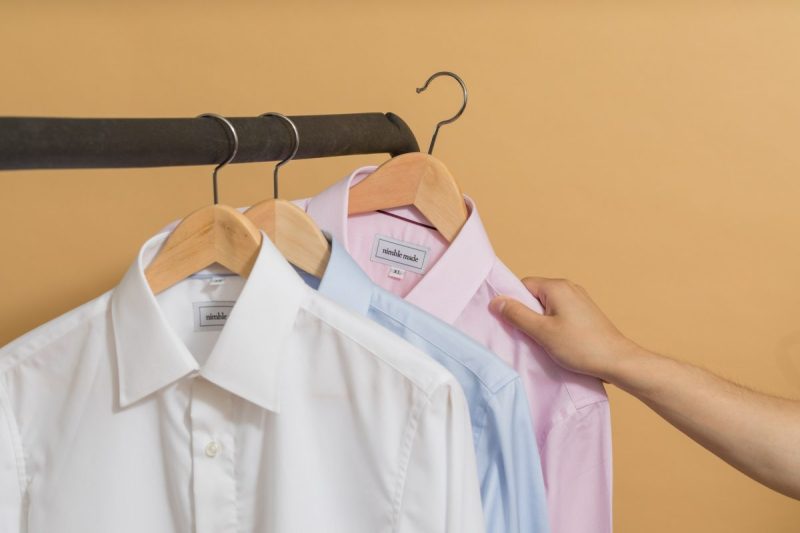
Nothing brings a grown man to tears faster than a massive sweat stain on an otherwise perfectly good shirt. It’s inevitable. The “investment” white dress shirt that always brings you luck on new client meetings is suddenly showing pit stains. The basic T-shirt you bought specifically for its minimalist appeal gets a grease mark right on the chest. The best chinos you’ve only worn once get a grass stain from one slip in the backyard. Knowing how to remove sweat stains from shirts – and your other favorite items – is essential.
Sure, you could just throw them away and buy new clothes, but these days disposable fashion is getting a bad rap, and dusting off a little thrift ingenuity seems downright trendy. We checked in with chemical engineer Dr. Daniel H. Jones for a few easy-to-use pointers to create our guide for how to remove sweat stains from shirts to make clothes look new again.

How to handle stains
Dr. Daniel H. Jones offers the seemingly simple advice, “Like dissolves like. For instance, use vinegar for coffee and other acidic stains.” Since we are not all chemical engineers, we’ve broken that down further.
- In general, a fresh stain is always easier to treat than an older one, so get on it as soon as possible.
- Gently blot the soiled area with a clean, white paper towel or cloth, but be careful: don’t drive the stain further into the fabric.
- After applying any of the below fixes, do not put items in the dryer unless the stain is completely removed. The dryer will cause the stain to set, making it extraordinarily difficult to remove. We also recommend washing on cold for the same reason: Hot water sets certain stains.

How to remove sweat stains
Nothing makes a shirt look nasty like a sweat stain does. Most commonly, stains are found in the shirt’s underarms. Why? The culprit is usually aluminum-based chemicals used in antiperspirants that get trapped in the shirt’s fabric when you sweat.
Tackling the stain
Use a mixture of one part dish soap and two parts hydrogen peroxide to attack the stain. According to Dr. Jones, the soap has both an “oily” (organic) side and a “salty” (ionic) side. “The ionic side dissolves in water, the organic side dissolves the grease. Hydrogen peroxide breaks down the organic complexes so the soap can dissolve them.”
- Apply the soap/hydrogen peroxide mixture to the stain.
- For particularly stubborn stains, sprinkle baking soda on the soaked area. The grains will provide a bit of abrasion to help dislodge the stain.
- Use a toothbrush (not the one you are currently using for dental hygiene) or a laundry brush to scrub the mixture into the stain.
- Let the cleaning materials soak in for an hour.
- Wash your shirt as normal.

How to remove sweat stains on dark clothing
Hydrogen peroxide may lightly bleach certain colored fabrics, so try this method on darker-hued shirts.
- Run the stain under warm water for a few minutes to thoroughly wet the area.
- Combine 4 tablespoons of baking soda with 1/4 cup warm water to make a paste.
- Apply a generous amount of the paste to the stained area.
- Gently rub your shirt together to help work the paste into the fabric.
- Let the paste sit for 30 minutes and then rinse the area.
- Wash as normal.

How to remove collar stains
Ring around the collar? Yeah, we get that. Those are caused by a combination of sweat, dead skin cells, oil, and residue from hair products. Here, we’ll rely on the soap’s organic properties to work it all out.
- Lay your shirt flat with the soiled collar facing up.
- Pour undiluted liquid laundry detergent directly onto the soiled area.
- Let the detergent soak into the collar for at least 30 minutes.
- Wash as normal.

How to remove oil-based stains on polyester
Spilled hamburger grease on your favorite performance golf shirt? We have the solution to try.
- Scatter a generous layer of baking soda across the stained portion and let it sit for 45 minutes to an hour, allowing the baking soda to absorb the excess grease and oil.
- Brush the baking soda to remove.
- Pour a generous amount of mild dishwashing soap on the stain. Once again, the soap’s “oily” side dissolves the grease. Wait 5 to 10 minutes.
- Wash the garment as normal.

How to remove stains with vinegar solutions
Vinegar has so many uses that you should always have a bottle in the house. Mix white vinegar with an equal portion of water and store it in a spray bottle and top it off with a generous squirt of dish soap. Besides being awesome for cleaning windows, it’s also great for treating various stains.
Mustard or grass stains: For that moment when the picnic is no picnic for your wardrobe. Gently remove as much mustard as possible with a spoon, then give the vinegar mixture a try.
- Apply a squirt of alcohol or lighter fluid.
- Soak the stain with our vinegar solution.
- Use a toothbrush to work out the stain.
- Flush it with water.
- Apply a few drops of hydrogen peroxide, followed immediately by a few drops of ammonia.
- Rinse with cool water, apply a few drops of vinegar, and rinse with water again.
- Wash the garment.
Strawberries: Same as above, but skip the lighter fluid/alcohol step.
Cherries: Squeeze lemon juice onto the stain, wait a couple of minutes, rinse, and let the garment dry in the sun. Here again, like dissolves like, and the lemon’s acid will break up the cherry stain. The natural sunlight, of course, has a bleaching effect.
Blood: Use an enzymatic cleaner before it sets in, then hit it with peroxide repeatedly.

How to prevent stains
While there’s only so much you could do for explosive hot dogs, “expressive” glasses of wine, and fruit-fingered toddlers, you could at least try to cut back on those sweat-related problems.
- Limit your caffeine and hot beverage intake. Both increase sweating, which in turn increases the risk of stains.
- Wear a plain white T-shirt under your dress shirt. Your inexpensive tee will bear the brunt of the stain, keeping your pricey dress shirt clean.
- Switch to an antiperspirant with no aluminum compounds or opt for more organic products that will keep you fresh and stain-free while allowing your body to perspire naturally.
- Wear a collar protector. These self-adhesive pads will adhere to your collar, protecting your shirt, while keeping you dry and comfortable.

More sweaty tips to remember
Why do you even get those stains, anyway? Your sweat comes out clear, so why the yellowing of your clothing? It has more to do with your deodorant mixing with the bacteria than anything else. Not only is the tip of switching to an organic deodorant important, but so is applying it correctly. But we have other helpful ways to keep the stains away.
- Switch to antiperspirant. This is the stuff that reduces sweating in the first place. You should also be applying this at night before you go to bed. Seriously, read the directions next time.
- If you wear both, put the antiperspirant on before the deodorant.
- Keep your armpit hair short. Just trim it up a bit every now and then.
Keep these items in your car or office
- An extra undershirt
- A bottle of the vinegar mixture
- Organic antiperspirant
If none of these ways to remove sweat stains from shirts or other items doesn’t work, then maybe they get turned into workout clothes. While you should try to prevent those stains from creeping in to start with, at least now you are armed with the ways to bring your shirts back to life after they’ve gone to the pits.
Editors' Recommendations
- What are the best shoes for your suit? The only style guide you need
- The 10 best men’s workout shirts to help you get fit in 2023
- These are the best travel shoes (so you don’t waste any space in your luggage)
- Take It from a Seattle Dude: These Are the Burliest Flannel Shirts for this Winter
- The 9 Best Short-Sleeve Shirts for Any Setting, From the Office to the Bar




